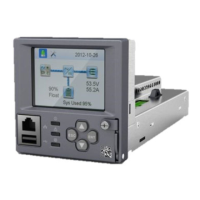Vertiv™ NetSure™ Control Unit (NCU) User Manual
Primary/Secondary Procedure:
Up to four (4) NCU controllers can be connected together when a power system requires a greater number of rectifiers
than can be controlled by a single NCU controller. One (1) controller is designated as the primary controller, the others
as secondary controllers. The rectifiers controlled by the secondary controllers are designated as Rectifier Group 2
through 4 in the menus.
NOTE!
Changing the Rectifier Expansion setting may take more than 3 minutes for the NCU to configure the feature.
1. Connect the NCU controllers in the multiple bays via the RS485 interface.
2. Set one of the NCU controllers as the primary controller.
3. Set all other NCU controllers as secondary controllers.
ALERT! DO NOT set the controller to Secondary from the Web Interface. You will not be able to log into the controller after
it automatically reboots into secondary mode. Controllers to be designated as secondary controllers need to be set locally via
the local keypad and display.
4. Set the address of the NCU controllers set as secondary controllers to 201, 202, or 203. Note that each secondary
controller must be set to a different address.
• Power Split Mode: Enables or disables the power split feature ("disabled" indicates the NCU system operates normally and
"enabled" indicates the NCU system is in Power Split Mode). See “Power Split Feature” on page 9 and “Power Split Feature”
on page 51.
• Power Split Current Limit Value: Current limit point for power system designated as “System A” in a "Power Split"
configuration.
• Delta Voltage: The offset voltage that the power system designated as “System A” in a "Power Split" configuration is set to.
It is suggested to leave this value at the default (0.5 volts).
• Outgoing Alarms Blocked:
- Normal: Alarms are processed normally.
- Blocked: Forces the alarm relays in the "off" state and blocks alarms from changing the relay state.
• EStop / EShutdown
- Disabled: Disables the Emergency Stop and Emergency Shutdown functions.
- EStop: Enables the Emergency Stop function. (If utilized in the system, an Estop signal shuts down and locks out the
system. The system must be manually restarted. Refer to the system instruction manual for restarting procedure.)
- EShutdown: Enables the Emergency Shutdown function. (If utilized in the system, an EShutdown signal shuts down the
system. The system automatically restarts when the signal is removed.)
• Audible Alarm
- Off: Disables the audible alarm.
- On: When a new alarm occurs, the audible alarm sounds. Press any key to silence the audible alarm.
- 3 min / 10 min / 1 hr / 4 hrs: When a new alarm occurs, the audible alarm sounds. The audible alarm automatically
silences after the selected time period.
• Auto/Manual State:
- Auto: The controller automatically controls the power system.

